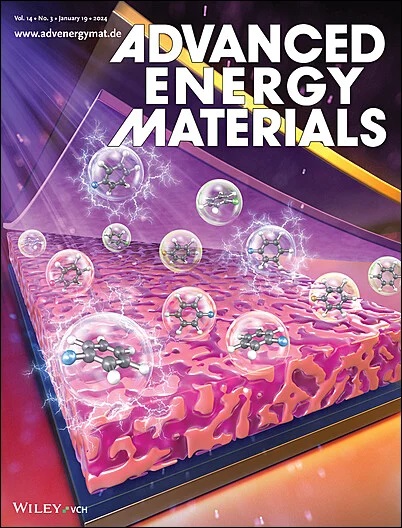解锁从锌废料中提取的长寿命锌硫水电池,为30个led供电
IF 24.4
1区 材料科学
Q1 CHEMISTRY, PHYSICAL
引用次数: 0
摘要
锌硫水溶液(Zn-S)可充电电池由于其安全性、容量、成本和效率等优点,正在成为有前景的下一代储能设备。然而,锌腐蚀、极化、低电导率和硫阴极体积膨胀是影响电池稳定性和容量的瓶颈。在此,我们报道了一种双重策略,包括磺胺(SA)作为稳定Zn的添加剂,与空心NixFeyO4配合以限制硫,减轻体积膨胀和提高电导率,以及碘作为氧化还原介质以改善Zn2+动力学。设计的电池在0.1 C时具有1260 mAh g−1的优异比容量,在1 C下循环1000次后容量保持率为81%,SA使锌阳极的析氢反应(HER)的腐蚀速率降低了3.5倍和2.8倍,这得到了拉曼和1H NMR光谱的支持,并得到了进一步的计算研究。采用SA制备的对称Zn||锌电池稳定时间超过770 h,表现出Zn阳极的超高稳定性。利用电化学原位拉曼光谱监测了ZnS的形成。设计的锌- s自制小袋电池为30个红色LED面板供电93小时,并进一步为风扇供电,表现出卓越的可持续性。本文章由计算机程序翻译,如有差异,请以英文原文为准。

Unlocking Long Life Aqueous Zinc-Sulfur Rechargeable Battery Derived from Zinc Waste Powering 30 LEDs
Aqueous Zinc-sulfur (Zn-S) rechargeable batteries are emerging as promising next-generation energy storage devices due to safety, capacity, cost and efficiency. However, Zn corrosion, polarization, low conductivity and volume expansion of sulfur cathode are the bottlenecks for battery stability and capacity. Herein, we report a dual strategy involving sulfanilamide (SA) as additive to stabilize Zn, paired with hollow NixFeyO4 to confine sulfur, mitigating volume expansion and enhancing conductivity along with iodine as redox mediator to improve the Zn2+ kinetics. The designed battery demonstrated an excellent specific capacity of 1260 mAh g−1 at 0.1 C with 81% capacity retention after 1000 cycles at 1 C. The SA mitigates the hydrogen evolution reaction (HER) by 3.5 times and 2.8-fold reduction in corrosion rate of Zn anode, which is, supported by Raman, and 1H NMR spectroscopy and furthercomplimented by computational studies. The symmetric Zn||Zn cell with SA was stable for more than 770 h, demonstrating an ultra-high stability of Zn anode. Formation of ZnS was monitered by electrochemical in-situ Raman spectroscopy. The designed Zn-S homemade pouch cell powered a panel of 30 red LED for 93 h and furthered powered fan, demonstrating exceptional sustainability.
求助全文
通过发布文献求助,成功后即可免费获取论文全文。
去求助
来源期刊

Advanced Energy Materials
CHEMISTRY, PHYSICAL-ENERGY & FUELS
CiteScore
41.90
自引率
4.00%
发文量
889
审稿时长
1.4 months
期刊介绍:
Established in 2011, Advanced Energy Materials is an international, interdisciplinary, English-language journal that focuses on materials used in energy harvesting, conversion, and storage. It is regarded as a top-quality journal alongside Advanced Materials, Advanced Functional Materials, and Small.
With a 2022 Impact Factor of 27.8, Advanced Energy Materials is considered a prime source for the best energy-related research. The journal covers a wide range of topics in energy-related research, including organic and inorganic photovoltaics, batteries and supercapacitors, fuel cells, hydrogen generation and storage, thermoelectrics, water splitting and photocatalysis, solar fuels and thermosolar power, magnetocalorics, and piezoelectronics.
The readership of Advanced Energy Materials includes materials scientists, chemists, physicists, and engineers in both academia and industry. The journal is indexed in various databases and collections, such as Advanced Technologies & Aerospace Database, FIZ Karlsruhe, INSPEC (IET), Science Citation Index Expanded, Technology Collection, and Web of Science, among others.
 求助内容:
求助内容: 应助结果提醒方式:
应助结果提醒方式:


